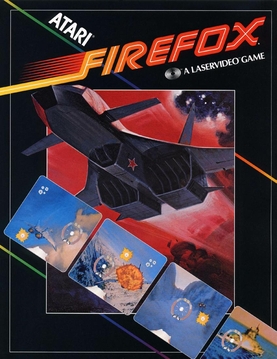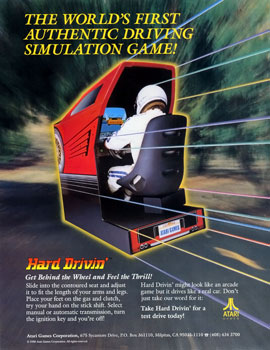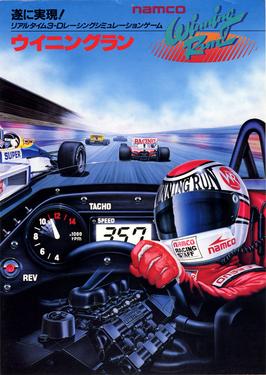
Pole Position is a racing arcade video game released by Namco in 1982. It was licensed to Atari, Inc. for US manufacture and distribution. Pole Position is considered one of the most important titles from the golden age of arcade video games. It was an evolution of Namco's earlier arcade racing electro-mechanical games, notably F-1 (1976), whose designer Sho Osugi worked on Pole Position.

Final Lap is a 1987 racing simulation video game developed and published by Namco. Atari Games published the game in the United States in 1988. It was the first game to run on Namco's then-new System 2 hardware and is a direct successor to Namco's Pole Position (1982) and Pole Position II (1983). It was ported to the Famicom by Arc System Works, making it Arc System Works' debut game.
1983 has seen many sequels and prequels in video games, such as Mario Bros. and Pole Position II, along with new titles such as Astron Belt, Champion Baseball, Dragon's Lair, Elevator Action, Spy Hunter and Track & Field. Major events include the video game crash of 1983 in North America, and the third generation of video game consoles beginning with the launch of Nintendo's Family Computer (Famicom) and Sega's SG-1000 in Japan. The year's highest-grossing video game was Namco's arcade game Pole Position, while the year's best-selling home system was Nintendo's Game & Watch for the third time since 1980.

Track & Field, also known as Hyper Olympic in Japan and Europe, is an Olympic-themed sports video game developed by Konami and released as an arcade video game in 1983. The Japanese release sported an official license for the 1984 Summer Olympics. In Europe, the game was initially released under the Japanese title Hyper Olympic in 1983, before re-releasing under the US title Track & Field in early 1984.

The Nintendo VS. System is an arcade system that was developed and produced by Nintendo. It is based on most of the same hardware as the Family Computer (Famicom), later released as the Nintendo Entertainment System (NES). As Nintendo was planning to release the NES in North America, they were aware of the video game crash of 1983 and its effects on the home console market. However by March 1984 the arcade industry recovered enough for a plan to introduce NES titles there, with the VS. System later being a presentation to players who did not yet own the console. It became the first version of the Famicom hardware to debut in North America.

Super Sprint is a racing video game released by Atari Games and Midway Games in 1986. Up to three players drive Formula One-like cars on a circuit that is viewed from above. The game is a successor to Gran Trak 10 and the Sprint series, which were black-and-white games from the 1970s. A sequel, Championship Sprint, was released later in the same year.
1985 saw many sequels and prequels in video games, such as Super Mario Bros. and Kung Fu, along with new titles such as Commando, Duck Hunt, Gauntlet, Ghosts 'n Goblins, Gradius, Hang-On, Space Harrier, Tetris and The Way of the Exploding Fist. The year's highest-grossing arcade video games were Hang-On and Karate Champ in the United States, and Commando in the United Kingdom. The year's best‑selling home system was the Nintendo Entertainment System (Famicom) for the second year in a row, while the year's best‑selling home video game was Super Mario Bros.
1984 saw many sequels and prequels along with new titles such as 1942, Boulder Dash, Cobra Command, Jet Set Willy, Karate Champ, Kung-Fu Master, Yie Ar Kung-Fu and Punch-Out!! The year's highest-grossing arcade games were Pole Position in the United States, for the second year in a row, and Track & Field in the United Kingdom. The year's best-selling home system was Nintendo's Family Computer (Famicom), which was only sold in Japan at the time.

Hang-On is an arcade racing game released by Sega in 1985 and later ported to the Master System. In the game, the player controls a motorcycle against time and other computer-controlled bikes. It was one of the first arcade games to use 16-bit graphics and uses the Super Scaler arcade system board, created with design input from Yu Suzuki, as technology to simulate 3D effects. The deluxe cabinet version also introduced a motion-controlled arcade cabinet, where the player's body movement on a large motorbike-shaped cabinet corresponds with the player character's movements on screen.

Firefox is a 1984 shoot 'em up arcade video game based on the 1982 Clint Eastwood film of the same name. It was produced in 1984 as Atari, Inc.'s only LaserDisc video game. Like Atari's first-person Star Wars and Empire Strikes Back, Firefox came as both an upright and sit down cabinet with a yoke style controller.

Astron Belt (アストロンベルト) is a LaserDisc video game in the form of a third-person, space combat rail shooter, released in arcades in 1983 by Sega in Japan, and licensed to Bally Midway for release in North America. Developed in 1982, it was the first major arcade laserdisc video game. The game combines full-motion video (FMV) footage from the laserdisc with real-time 2D graphics. The arcade game was available in both upright and cockpit arcade cabinets, with the latter having illuminated buttons on the control panel, a larger 25" monitor, and a force feedback vibrating seat.

Pole Position II is the sequel to racing simulation game Pole Position, released by Namco for arcades in 1983. As with its predecessor, Namco licensed this game to Atari, Inc. for US manufacture and distribution. Atari Corporation released a port as the pack-in game for its Atari 7800 ProSystem console launch in 1986. Pole Position arcade machines can be converted to Pole Position II by swapping several chips.

Final Lap 2 is an racing simulation game released by Namco for arcades in 1990. It is the arcade sequel to Final Lap and runs on Namco System 2 hardware.

Hard Drivin' is a sim racing arcade video game developed by Atari Games in 1989. Players test drive a sports car on courses that emphasize stunts and speed. It features one of the first 3D polygon driving environments via a simulator cabinet with a haptic vibrating steering wheel and a custom rendering architecture.

F-1 is a 1976 electro-mechanical arcade racing game developed and published by Nakamura Manufacturing Company (Namco), and distributed in North America by Atari, Inc. The player uses a steering wheel to control a Formula One racer, which must avoid collision with other vehicles. The game uses a miniature diorama with small, plastic cars to represent the player's car and opponents on a physical, rotating track, while also featuring a projector system and lighting tricks to create the illusion of racing.

Enduro Racer (エンデューロレーサー) is an arcade racing game from Sega. It was released in 1986 with two arcade cabinet versions, a stand-up cabinet with handlebars and a full-sized dirt bike cabinet. It is often seen as a dirt racing version of Hang-On, as it uses a similar engine and PCB. The game was later released for the Master System in 1987, the ZX Spectrum and Commodore 64 in 1988, and the Amstrad CPC and Atari ST in 1989.

Monaco GP is an arcade racing game released by Sega in November 1979 in Japan, and January 1980 worldwide. An upgraded version, Pro Monaco GP, was released later in 1980. One of the last Sega games to use TTL chips instead of a microprocessor CPU, the game has players race against a clock and pass rival racers while attempting to earn points driving through five areas.

Winning Run is a first-person arcade racing simulation game developed and published by Namco in late December 1988 in Japan, before releasing internationally the following year. The player pilots a Formula One racer, with the objective being to complete each race in first place, all while avoiding opponents and other obstacles, such as flood-hit tunnels, pits and steep chambers. It was the first game to run on the Namco System 21 arcade hardware, capable of 3D shaded polygons.

Thunder Ceptor is a 3D rail shooter arcade game that was released by Namco in 1986. It usurped both Libble Rabble and Toy Pop as the company's most powerful 8-bit arcade games, was the first game from them to use an analogue (360-degree) joystick. A stereoscopic 3-D sequel, 3-D Thunder Ceptor II, was released towards the end of the year.

















